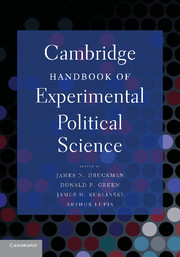Book contents
- Frontmatter
- Contents
- List of Tables
- List of Figures
- Contributors
- Acknowledgments
- INTRODUCTION
- PART I DESIGNING EXPERIMENTS
- PART II THE DEVELOPMENT OF EXPERIMENTS IN POLITICAL SCIENCE
- PART III DECISION MAKING
- PART IV VOTE CHOICE, CANDIDATE EVALUATIONS, AND TURNOUT
- PART V INTERPERSONAL RELATIONS
- PART VI IDENTITY, ETHNICITY, AND POLITICS
- PART VII INSTITUTIONS AND BEHAVIOR
- 24 Experimental Contributions to Collective Action Theory
- 25 Legislative Voting and Cycling
- 26 Electoral Systems and Strategic Voting (Laboratory Election Experiments)
- 27 Experimental Research on Democracy and Development
- PART VIII ELITE BARGAINING
- PART IX ADVANCED EXPERIMENTAL METHODS
- AFTERWORD
- Name Index
- Subject Index
- References
26 - Electoral Systems and Strategic Voting (Laboratory Election Experiments)
Published online by Cambridge University Press: 05 June 2012
- Frontmatter
- Contents
- List of Tables
- List of Figures
- Contributors
- Acknowledgments
- INTRODUCTION
- PART I DESIGNING EXPERIMENTS
- PART II THE DEVELOPMENT OF EXPERIMENTS IN POLITICAL SCIENCE
- PART III DECISION MAKING
- PART IV VOTE CHOICE, CANDIDATE EVALUATIONS, AND TURNOUT
- PART V INTERPERSONAL RELATIONS
- PART VI IDENTITY, ETHNICITY, AND POLITICS
- PART VII INSTITUTIONS AND BEHAVIOR
- 24 Experimental Contributions to Collective Action Theory
- 25 Legislative Voting and Cycling
- 26 Electoral Systems and Strategic Voting (Laboratory Election Experiments)
- 27 Experimental Research on Democracy and Development
- PART VIII ELITE BARGAINING
- PART IX ADVANCED EXPERIMENTAL METHODS
- AFTERWORD
- Name Index
- Subject Index
- References
Summary
It can be complicated to attempt to understand how election mechanisms and other variables surrounding an election determine outcomes. This is because the variables of interest are often intertwined; thus, it is difficult to disentangle them to determine the cause and effect that variables have on each other. Formal models of elections are used to disentangle variables so that cause and effect can be isolated. Laboratory election experiments are conducted so that the causes and effects of these isolated variables from these formal models can be empirically measured. These types of experiments are conducted within a single location, where it is possible for a researcher to control many of the variables of the election environment and thus observe the behavior of subjects under different electoral situations. The elections are often carried out in computer laboratories via computer terminals, and the communication between the researcher and subjects occurs primarily through a computer interface. In these experiments, subjects are assigned as either voters or candidates, and, in some cases, they are given both roles. Voters are rewarded based on a utility function that assigns a preference for a particular candidate or party. Candidates are typically rewarded based on whether they win the election, but sometimes their rewards depend on the actions they take after the election.
- Type
- Chapter
- Information
- Cambridge Handbook of Experimental Political Science , pp. 369 - 383Publisher: Cambridge University PressPrint publication year: 2011
References
- 2
- Cited by



